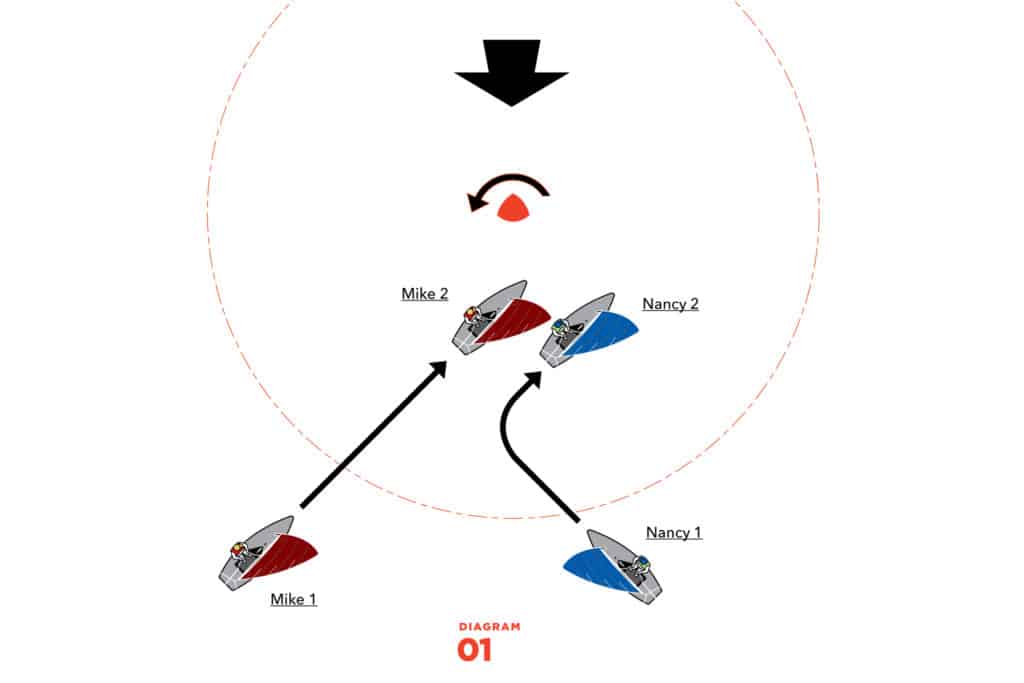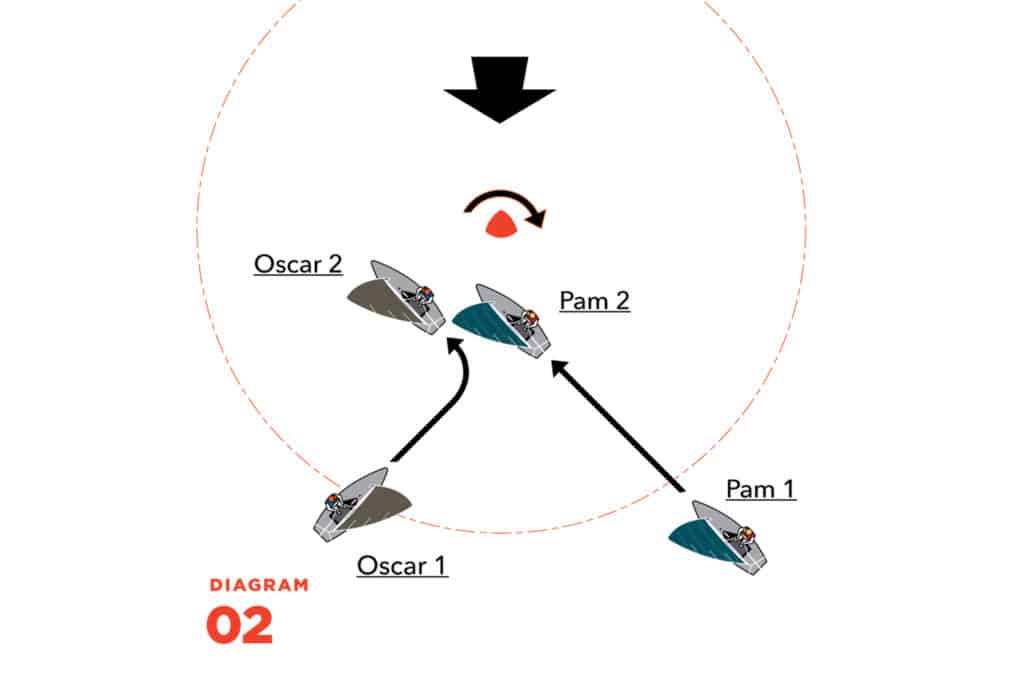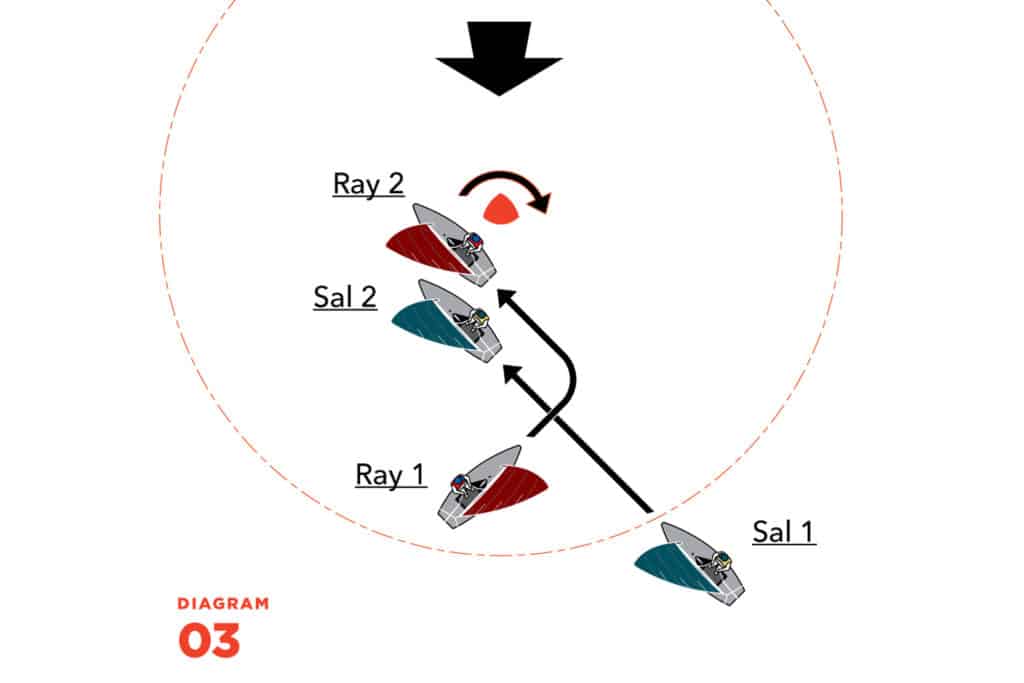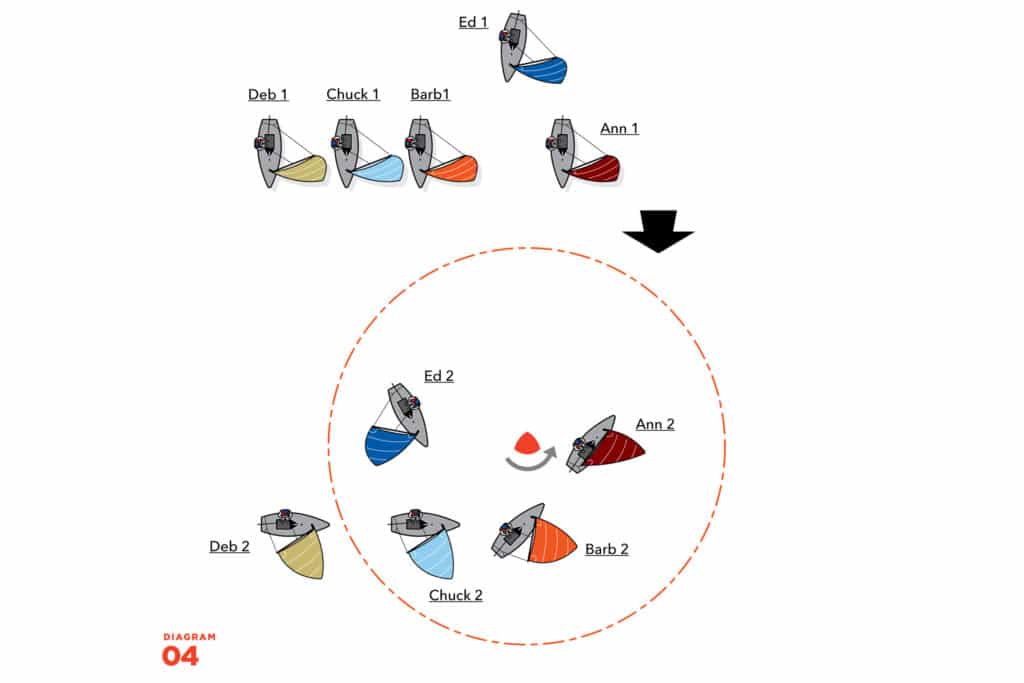This is the fourth in a series on the rights and obligations of boats when one is required to give the other mark-room. The first three articles extensively discussed Rule 18.2(b)—the most important of the three rules that requires one boat to give another mark-room. I estimate that about 90 percent of the situations in which mark-room must be given are covered by Rule 18.2(b), 9 percent by Rule 18.2(a), and 1 percent by Rule 18.3(b). This installment examines situations in which Rules 18.2(a) and 18.3(b) apply.
Rule 18.2(a) starts out by stating: “When boats are overlapped the outside boat shall give the inside boat mark-room …” The next words, “unless Rule 18.2(b) applies,” sharply narrow the range of situations in which Rule 18.2(a) applies. It never applies “if boats are overlapped when the first of them reaches the zone” or “if a boat is clear ahead when she reaches the zone.” There are two additional limits on when Rule 18.2(a) applies. The rule is part of Rule 18, so it can only apply when the conditions in Rule 18.1 are met—i.e., when Rule 18 is “switched on” by Rule 18.1. Finally, whenever Rule 18.3 applies, all parts of Rule 18.2, including Rule 18.2(a), are “switched off.”
So, under what circumstances does Rule 18.2(a) make a difference? All the Rule 18.2(a) situations I know of occur either at a windward mark or a leeward mark when a bunch of boats are overlapped as they approach a mark. I will examine four such situations.
In the first diagram, Nancy on starboard tack is about even with Mike, who is on port. The windward mark is to be left to port. Nancy is about two lengths below the starboard-tack layline. When the boats reach the zone, Rule 18, and in particular Rule 18.2(b), does not apply because they are on opposite tacks on a beat to windward (see Rule 18.1(a)) and they are not overlapped (see the definition Clear Astern and Clear Ahead; Overlap). Nancy tacks to leeward of Mike. After Nancy turns past head to wind, Rule 18 begins to apply because the boats are in the zone and no longer on opposite tacks. At that time, they are also overlapped with Nancy being the outside boat. Therefore, Rule 18.2(a) begins to apply at that time, and it requires Nancy to give Mike mark-room while the boats remain overlapped. After Nancy has borne off to a close-hauled course, Rule 11 begins to apply, giving Nancy right of way. Mike is entitled to room from Nancy to leave the mark to port, and after he has sailed to a point at which he could tack and fetch the mark, he will also be entitled to room to tack because he is overlapped inside and to windward of Nancy (see the definition Mark-Room). Later, when Mike turns past head to wind during his tack to fetch and then round the mark, Rule 18.2(a), and indeed all parts of Rule 18, will no longer apply because the boats will then be on opposite tacks on a beat to windward.
Why is Rule 18.2(a) needed here? If it did not apply, then just after Position 2 Nancy could luff up to head to wind and force Mike to the wrong side of the mark. The purpose of Rule 18 is to enable boats to round the mark in a fair and orderly manner. It would be quite chaotic if Rule 18 allowed Nancy to force Mike to the wrong side of the mark. He would then have to circle back into the path of other boats approaching the mark.
The second diagram involves Oscar on port tack approaching Pam on starboard as they near a windward mark to be left to starboard. It’s the mirror image of the previous example, and the application of the rules is identical. After Oscar passes head to wind, Rule 18.2(a) requires him to give Pam mark-room.
In the next scenario, Ray on port tack and Sal on starboard are approaching a windward mark to be left to starboard. Ray is far enough ahead of Sal, and Sal is on track far enough to leeward of the mark, that Ray can cross Sal’s bow on port and then tack onto starboard as shown in the diagram. Ray’s speed drops as he tacks resulting in Sal becoming overlapped outside of Ray. Rule 18.2(b) never applied because the boats reached the zone while on opposite tacks on a beat to windward. Rule 18.2(a) requires Sal to give Ray mark-room after the overlap between them begins. Ray then enjoys the same benefits under Rule 18.2(a) that Mike and Pam had in the previous examples.
Alert rule readers will note that, because Ray obtained an inside overlap by tacking to windward of Sal, Rule 18.2(e) applies between Ray and Sal. That rule states that if “the outside boat [Sal] has been unable to give mark-room [to Ray], she is not required to give it.” But Sal can easily give Ray mark-room—Sal has plenty of open water in which to bear away.
The fourth diagram, in which Rule 18.2(a) applies in a traffic jam at a leeward mark, is copied from ISAF Case 59. The width of a boat running downwind with her boom all the way out, measured from her windward rail to the end of her boom, is about equal to her length. Add in a couple of feet of clearance between adjacent boats and it’s easy to see that when four or more boats are sailing abreast directly downwind, only the three most inside boats will be able to enter the zone. Any boats outside those three can’t fit into the three-length zone until the inside boats begin to round the mark.
In our example, Ann, Barb, and Chuck enter the zone while running downwind, and all three are clear ahead of Ed when they reach the zone. Initially, Deb is also clear ahead of Ed. Because Deb is forced to remain outside the zone, she does not enter the zone until well after Ann, Barb, and Chuck. In fact, Ed enters the zone before Deb; when Ed reaches the zone, he is clear astern of Deb, and Deb is outside the zone. Therefore, neither of the two conditions under which Rule 18.2(b) applies is met for Deb and Ed, so Rule 18.2(b) does not apply between them. Before Position 2, when Deb jibes toward the mark, an overlap begins between Ed and Deb, with Deb the outside boat. At that moment, Rule 18.2(a) begins to apply between them, requiring Deb to give Ed mark-room.
Life is tough for Deb. She is required by Rule 18.2(b)’s first sentence to give mark-room to Ann, Barb, and Chuck. She’s also required by Rule 18.2(a) to give mark-room to Ed, who had been well astern of her. What’s more, Ed is required by Rule 18.2(b)’s second sentence to give Ann, Barb, and Chuck mark-room, so the room that Deb is required to give Ed includes the space Ed needs to fulfill his Rule 18.2(b) obligations to Ann, Barb, and Chuck (see the definitions Mark-Room and Room).
Situations where Rule 18.3(b) requires one boat to give another mark-room happen only at windward marks. As an example, say you are on starboard tack fetching a mark to be left to port. Jane is on port tack and inside the zone. Without breaking Rule 13, Jane tacks from port to starboard dead ahead or slightly upwind of your track. Jane loses speed as she tacks, and you get an inside overlap on her. From the moment you get the inside overlap, Rule 18.3(b) requires Jane to give you mark-room. The message to the Janes of the world is clear: If you must tack inside the zone ahead of a boat that’s fetching the mark, delay your tack until you’ve sailed far enough past the fetching boat’s track so you’ll be able to give her room to round inside you after you tack.
This article first appeared in the May/June 2014 issue of Sailing World and is part of a series. Click here to read the other articles in the Mark-Room series. Click here to read more about the Racing Rules of Sailing.













